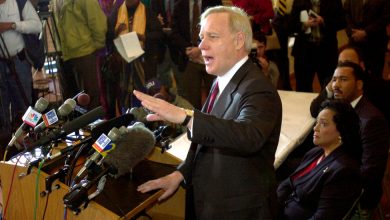A Battle Over How to Battle Over Roe: Protests at Justices’ Homes Fuel Rancor

WASHINGTON — For the protesters chanting loudly outside Justice Brett M. Kavanaugh’s home, incivility was the point.
They said they wanted to impinge on his privacy with picket signs and chants of “We will not go back!” to condemn the Supreme Court justice’s apparent support for ending the constitutional right to privacy that has guaranteed access to abortion since Roe v. Wade was decided nearly 50 years ago.
“We can be noncivil,” insisted Lacie Wooten-Holway, a 39-year-old teaching assistant who has been protesting regularly outside the home of her neighbor, Justice Kavanaugh, since October. She called it “absolutely insane” that the court might dictate what women do “with the only literal home we’ll have for the rest of our lives, which is our bodies.”
But the protests outside the homes of several justices, which erupted after the leak of a draft opinion indicating the court’s conservative majority is ready to overturn Roe, has sparked another searing debate about appropriate forms of protest at a moment of enormous upheaval in a deeply polarized country.
Though they have been largely peaceful, the protests at the homes of Justice Kavanaugh and Justice Samuel A. Alito Jr. have drawn criticism from Republicans, who angrily accused Democrats of improperly pressuring the court. Justice Clarence Thomas said the court’s conservatives were being “bullied.” Senator Tom Cotton, Republican of Arkansas, called for the protesters to be prosecuted criminally.
Those critiques have drawn a fierce rebuke from supporters of abortion rights, who point to years of protests by abortion opponents in front of abortion clinics and the homes of doctors. And they accuse Republicans who defended the Jan. 6 attackers at the Capitol of hypocrisy for being suddenly gripped by concern about passionate protesters.
Many of the protesters have expressed concern that the scrutiny over the protests has distracted from the real issue — restricting a woman’s right to have an abortion — that has prompted the demonstrations. The administration has expressed similar concerns.
But the debate underscores the divisions in a country that cannot even agree on how or when to protest its disagreements. And it foreshadows a potentially more confrontational period this summer if the court issues a final opinion that overturns the right to abortion.
The White House has tried to balance both sides of the debate.
Asked about the protests outside justices’ homes last week, Ms. Psaki said she did not have “an official U.S. government position on where people protest,” adding that President Biden wanted “people’s privacy to be respected.”
After an outcry from critics of the protests at justice’s homes, Ms. Psaki said on Twitter that while the president believed in the right to protest, “that should never include violence, threats or vandalism.”
From Opinion: A Challenge to Roe v. Wade
Commentary by Times Opinion writers and columnists on the Supreme Court’s upcoming decision in Dobbs v. Jackson Women’s Health Organization.
- Gail Collins: The push to restrict women’s reproductive rights is about punishing women who want to have sex for pleasure.
- Jamelle Bouie: The logic of the draft ruling is an argument that could sweep more than just abortion rights out of the circle of constitutional protection.
- Matthew Walther, Editor of a Catholic Literary Journal: Those who oppose abortion should not discount the possibility that its proscription will have some regrettable consequences. Even so, it will be worth it.
- Gretchen Whitmer, Governor of Michigan: If Roe falls, abortion will become a felony in Michigan. I have a moral obligation to stand up for the rights of the women of the state I represent.
“Judges perform an incredibly important function in our society, and they must be able to do their jobs without concern for their personal safety,” she wrote.
On Wednesday, as tensions simmered, the Justice Department directed U.S. Marshals to help “ensure justices’ safety.”
Many Democrats have shrugged off criticism that the protests are inappropriate, noting that protesters often demonstrate outside their homes as well. But Senator Richard J. Durbin, an Illinois Democrat who is the chairman of the Judiciary Committee, called protesting outside the homes “reprehensible.” And the Senate passed a bill this week to provide security for the immediate relatives of the nine justices if the Supreme Court marshal deems it necessary.
Ms. Wooten-Holway said she tried to abide by a set of rules: The protest must remain peaceful and remain on public property outside Justice Kavanaugh’s home, where she said attendees bearing ponchos and signs crowded into the tree-lined street of the suburban neighborhood of Chevy Chase, Md.
In Justice Alito’s neighborhood in Alexandria, Va., demonstrators flanked by police cars walked through the streets hoisting signs, including one that asked, “Does this feel intrusive?”
But critics say the protesters should not be there at all. Some Republicans have pointed to a 1950 federal statute that says those “with the intent of influencing any judge” who “pickets or parades in or near a building housing a court of the United States, or in or near a building or residence occupied or used by such judge” would be breaking the law. The Justice Department declined to comment when asked about potential prosecutions.
“You must vigorously investigate and prosecute the crimes committed in recent days,” Senator Josh Hawley, Republican of Missouri, wrote in a letter to the Justice Department. “The rule of law demands no less.”
The protests have not been limited to Washington. Over the weekend, Senator Susan Collins, Republican of Maine, called the police on demonstrators who used chalk on the sidewalk outside her Bangor home to write a message asking her to support abortion rights legislation. Two churches in Colorado were vandalized last week with spray-painted messages of “my body, my choice.”
Rebecca Overmyer-Velázquez, a Whittier College professor focusing on global social movements, said history has shown that protests — even ones that make people uncomfortable — are at times necessary to create change. She pointed to the civil rights movement, when college students like John Lewis, who went on to become a congressman from Georgia, were arrested dozens of times for sitting at whites-only lunch counters and in other protests against Jim Crow-era laws in the South.
“I’m not convinced that the line is whether it’s legal or illegal,” Ms. Overmyer-Velázquez said. “I think the question is: Is this decision really going to impact our lives very, very seriously? And it is, no doubt.”
The State of Roe v. Wade
What is Roe v. Wade? Roe v. Wade is a landmark Supreme court decision that legalized abortion across the United States. The 7-2 ruling was announced on Jan. 22, 1973. Justice Harry A. Blackmun, a modest Midwestern Republican and a defender of the right to abortion, wrote the majority opinion.
What was the case about? The ruling struck down laws in many states that had barred abortion, declaring that they could not ban the procedure before the point at which a fetus can survive outside the womb. That point, known as fetal viability, was around 28 weeks when Roe was decided. Today, most experts estimate it to be about 23 or 24 weeks.
What else did the case do? Roe v. Wade created a framework to govern abortion regulation based on the trimesters of pregnancy. In the first trimester, it allowed almost no regulations. In the second, it allowed regulations to protect women’s health. In the third, it allowed states to ban abortions so long as exceptions were made to protect the life and health of the mother. In 1992, the court tossed that framework, while affirming Roe’s essential holding.
What would happen if Roe were overturned? Individual states would be able to decide whether and when abortions would be legal. The practice would likely be banned or restricted heavily in about half of them, but many would continue to allow it. Thirteen states have so-called trigger laws, which would immediately make abortion illegal if Roe were overturned.
She said the question was not whether protests were legal, but whether they were “moral.”
Mr. Biden has faced this kind of question before.
After demonstrations and riots erupted in the summer of 2020 following the murder of George Floyd by a police officer, the Biden campaign repeatedly condemned violence and looting. And last year, advocates targeted two Democratic senators holding up Mr. Biden’s domestic agenda — taking kayaks to protest near a yacht belonging to Senator Joe Manchin III of West Virginia and following Senator Kyrsten Sinema of Arizona into a university restroom.
When Mr. Biden was pressed on whether those tactics were appropriate, he equivocated.
“I don’t think they’re appropriate tactics, but it happens to everybody,” Mr. Biden said at the time. “It’s a part of the process.”
Some demonstrators have pointed out the irony that some of the same Republicans who criticized the investigation into the Capitol attack have now turned attention to the law enforcement response to protests outside the homes of Supreme Court justices.
If those protesting outside the homes of justices should be prosecuted, “then why is not every single person from Jan. 6 in jail?” Ms. Wooten-Holway asked.
Some of those who disagree with her stance on abortion also support the direct confrontation. Brandi Swindell, who flew to Washington from Idaho to protest outside the Capitol on Wednesday to support the repeal of Roe, said “going to the justices’ house in a peaceful way can be acceptable.”
But Michelle Peterson, a Maryland resident who went to the Capitol to support women across the country who may face restrictions on abortion, expressed unease about taking the protest to the home of a justice.
“I don’t know how I quite feel about it,” she said. “Their families are there.”
In recent days, Ms. Wooten-Holway, who said she had had an abortion and survived sexual assault, decided to take a break from the demonstrations after anti-abortion campaigners gathered outside her home last weekend and her family received threatening messages.
She has since decided to hire private security. She drew a distinction between her protesting across the street from Justice Kavanaugh’s home and those who gathered outside her home this weekend.
“I’m protesting the fact Kavanaugh is trying to strip rights and they’re protesting me exercising the First Amendment,” she said. “And I don’t have a wall of security.”
Zach Montague contributed reporting. Kitty Bennett contributed research.



